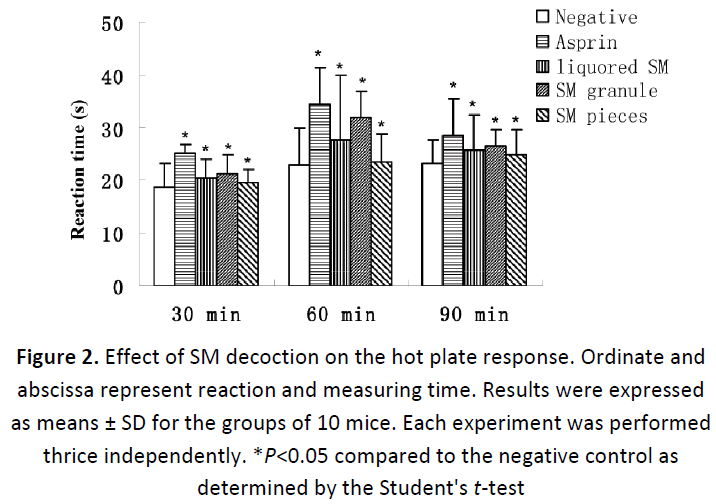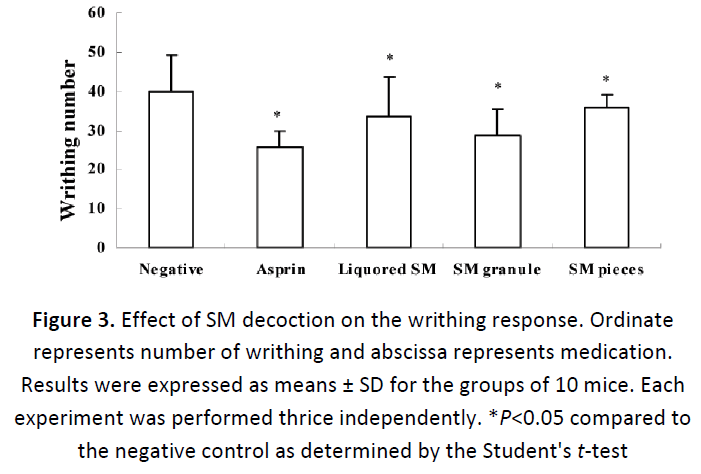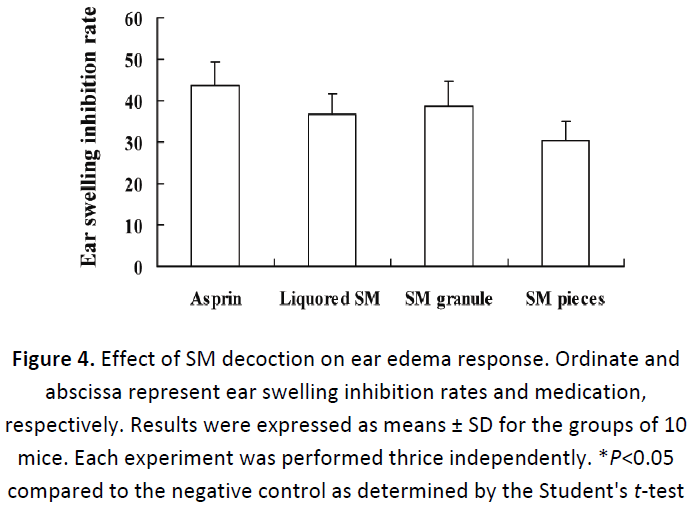ISSN : 2348-9502
American Journal of Ethnomedicine
Comparative Analgesic and Anti- Inflammatory Effect of Salviae miltiorrhizae Pieces and its Products in Mice
1School of Pharmacy, Shandong University of Traditional Chinese Medicine (TCM), Jinan, 250355, China
2School of Basic Medical Science, Shandong University of TCM, Jinan, 250355, China
Abstract
Lectins were precipitated by ammonium sulphate precipitation method. Carbohydrate and proteins were detected by thin layer chromatography and infrared spectroscopy techniques. Crude lectins were partially characterized by its binding affinity with human erythrocytes by hemagglutination inhibition assay and their molecular weights were determined by SDS-page gel electrophoresis. The amount of proteins was quantitatively measured by Lowry method. Antibacterial and antifungal activities were investigated by disk diffusion assay. Salmonella induced hemagglutination inhibition activities were observed. Isolated lectins contained carbohydrates and protein conjugates in their structures. The isolated lectins showed molecular weight was about 45 kD and 18 kD and seemed as a dimeric. It showed weaker antibacterial and antifungal activities. Conclusions: The seed of Lablab purpureous is food stuff and it may be considered as good source of proteins and as an antimicrobial protective agent.
Keywords
Analgesic effect, Anti-inflammatory effect, Salviae miltiorrhizae.
INTRODUCTION
The traditional Chinese medicine Danshen, derived from the dry root of Salviae miltiorrhizae Bge (SM) (Fig 1), has been widely applied to the treatment of irregular menstruation, algomenorrhea, angina pectoris, hepatauxe, etc [1-3]. In recent years, aqueous Danshen extract has been documented to possess analgesia and antiinflammatory properties in vitro [4,5]. Many different medication forms for SM are used in clinic, including crude SM pieces, SM formula granule, liquored SM pieces, SM tablet and SM capsule, etc. Moreover, different forms are often used interchangeably. In recent years, SM formula granule is widely used in all medication forms. However, no document suggested the different pharmacological activities of these SM medication forms. In order to explore the comparative analgesic and anti-inflammatory effect of Salviae miltiorrhizae pieces and its products, crude SM pieces, SM formula granule and liquored SM pieces were compared by carrying out hot plate test, writhing test and ear edema test.
MATERIALS AND METHODS
Reagent and animals
Crude SM pieces, SM formula granule, liquored SM pieces were purchased from Tianjiang pharmaceutical Co., Ltd. (China, Jiangyin). Chemical reagents used in the study are analytically pure. Aspirin was acquired from Dayang Pharmaceutical Technology Corporation (Beijing, China. Kunming mice were offered by Shandong University of TCM. Hot plate was from Beijing gene and life science Corporation (China).
Decoction preparation
Crude SM pieces and its liquored SM pieces were prepared into decoction in accordance with the Chinese Pharmacopoeia. Viz, SM pieces were powered and extracted via reflux with water for 3h. Then the filtrate of the extract was concentrated to 0.2 g·mL-1 crude drug. SM formula granule were heated and dissolved in water to a final concentration of 0.2 g·mL-1 crude drug.
Hot plate test
The hot plate test is assessed the effect of analgesic by measuring reaction time [6]. When mice were placed on a heated surface, they would perform a specified behavior (hind paw-licking or jumping) in response to painful thermal stimuli. In the test, fifty mice were randomly and averagely divided into positive control group (aspirin), negative control group (normal saline), SM pieces group, SM formula granule group and liquored SM pieces group. Before the experiment, Kunming mice were selected for the reaction time between 5 to 30 s. The hot plate was kept at a temperature of 55 ± 0.1 °C. The reaction time for mouse was recorded before and 60, 120 and 180 min after the intragastric administration of the medicine (0.015 mL g-1 body) or normal saline (0.015 mL g-1 body) respectively.
Writhing test
The writhing test is a chemical visceral pain model by measuring the effect of analgesic activity [7]. Each mouse was injected intraperitoneally with 0.2 ml acetic acid solution (0.7%, v/v) half an hour after the intrathecal administration of the drugs (0.015 mL g-1 body) or normal saline (0.015 ml g-1 body). Five minutes later, mice were individually placed into glass cylinders and their abdominal muscles contracted with a stretching of the hind limbs. The effect of the analgesic was expressed by the number of writhes observed by each mouse for 30 min.
Ear edema test
Anti-inflammatory activity was assessed by conducting ear edema test as described by Gad [8]. Groups of mice were given the intraperitoneal administration of the drugs (0.2 mL) or normal saline (0.2 mL). Half an hour later, 0.2 mL of xylene was spread on the surface of left ear of each mouse under anaesthesia, while the right ear was considered as control. Four hours after the intraperitoneal administration, all mice were sacrificed and both ears were cut off along their ears baseline. Ear swelling inhibition was determined by the formula:

Where A and B denotes ear swelling of the negative group and the drug groups, respectively.
Statistic analysis
Each experiment was repeated thrice, and all data were expressed as mean ± standard deviation (SD) and analyzed by SPSS11.0 statistical software. Statistical significance was determined by ANOVA followed by student's t-test. P value of less than 0.05 was considered statistically significant.
RESULTS
Effect of SM decoction on the hot plate response
The results indicated that the SM decoction prolonged the reaction time for nociception above the control value from the beginning to 90 min obviously. In a series of SM decoction, SM formula granule decoction is superior to the crude SM pieces decoction, but no significance occurred in the experiment (Fig.2).
Figure 2: Effect of SM decoction on the hot plate response. Ordinate and abscissa represent reaction and measuring time. Results were expressed as means ± SD for the groups of 10 mice. Each experiment was performed thrice independently. *P<0.05 compared to the negative control as determined by the Student's t-test
Effect of SM decoction on the writhing response
Compared with the negative control, the SM formula granule decoction extended the latency and reduced the number of writhes apparently, and the aspirin was the best analgesic drug among the six groups. The experiment data also showed that the SM formula granule decoction possessed better analgesic effect than crude SM decoction (Fig. 3).
Figure 3: Effect of SM decoction on the writhing response. Ordinate represents number of writhing and abscissa represents medication. Results were expressed as means ± SD for the groups of 10 mice. Each experiment was performed thrice independently. *P<0.05 compared to the negative control as determined by the Student's t-test
Effect of SM decoction on ear edema response
In the ear edema experiment, the edema extent of negative control is serious, but the data of the SM decoction groups is relative lighter. Compared with the crude SM decoction, the SM formula granule decoction had a better effect in the aspect of anti-inflammatory (Fig. 4).
Figure 4: Effect of SM decoction on ear edema response. Ordinate and abscissa represent ear swelling inhibition rates and medication, respectively. Results were expressed as means ± SD for the groups of 10 mice. Each experiment was performed thrice independently. *P<0.05 compared to the negative control as determined by the Student's t-test
DISCUSSION
Salviae miltiorrhizae Bge, a traditional Chinese medicine, has the function of extending blood vessel, suppressing platelet aggregation, improving cerebral circulation and relieving pain [9-11]. In this experiment, the results testified that three SM decoctions possessed obviously analgesic and anti-inflammatory activities. However, their pharmacological mechanisms still remain unclear. It documented that salvianolic acid A and tanshinone may be the effective chemical constituents for analgesic and antiinflammatory [12,13]. Our results also showed that SM formula granule and liquored SM pieces had better analgesic and antiinflammatory effect than crude SM pieces, and the highest activity was SM formula granule, but no statistic significance occurred amid the three medicinal agents described above. Our experiments partly explained the clinical significance for the preparation of SM. For the liquored SM, liquored process can increase the amount of dissolution of the active ingredients for tanshinone, and thereby enhance its effect [14-17]. While SM formula granule decoction showed the highest pharmacological activities, because SM formula granules were carried out the serial processing, such as extraction, concentration, separation, drying and granule process, resulting in the high concentration of the active ingredients and improved medicinal property [18].
CONCLUSION
Although SM possess analgesia and anti-inflammatory properties, our study preliminary confirmed the fact that SM formula granule is superior to the crude SM pieces in clinic for analgesic and antiinflammatory.
ACKNOWLEDGEMENT
This work was kindly fully supported by the SRT grand (2014), Experimental center of Shandong University of TCM.
REFERENCES
- National Pharmacopoeia Committee. Chinese Pharmacopoeia. Beijing: Chinese medical science and technology press, 2010, 70-71.
- Zhu Y. Chinese materia medica: chemistry, pharmacology and applications. Amsterdam: Harwood Academic Publishers, 1998, 459- 463.
- Chun-sheng L, Hsiao-meng Y, Yun-hsiang H, Chun P, Chi-fen S. Radix salviae miltiorrhizae and Rhizoma ligustici wallichii in coronary heart disease. Chin Med J. 1978, 4(1):43-6.
- Ren GH, Li YK, Kang XY. Anti- inflammatory and analgesic actions of Compound Danshen Injection. Modern medicine health, 2010, 14: 2081-2082.
- Du GH, Zhang JT. The General Situation and Progress of the Modern Research of Red Sage Root (Radix Salviae mtiorrhizae). Herald of Medicine 2004, 23: 355-360.
- EDDY NB, LEIMBACH D. Synthetic analgesics. II. Dithienylbutenyl- and dithienylbutylamines. J Pharmacol Exp Ther 1953, 107: 385-393.
- Collier HO, Dinneen LC, Johnson CA, Schneider C. The abdominal constriction response and its suppression by analgesic drugs in the mouse. Br J Pharmacol Chemother 1968, 32: 295-310.
- Gad S C. The mouse ear swelling test (MEST) in the 1990s. Toxicology 1994, 93: 33-46.
- Gao YG, Wang LZ, Tang JX. Anti- Inflammatory Actions of Tanshinone. Chinese Journal of Integrated Traditional and Western Medicine, 1983, 3: 300-302.
- Yang JY, Zheng J. Research Progress of Danshen Pharmacological Effect. Chinese Journal of Clincal Practical Medicine. 2007, 8: 45-47.
- Frishman WH, Sinatra ST, Moizuddin M. The use of herbs for treating cardiovascular disease. Seminars in Integrative Medicine, 2004, 2(1): 23-35.
- Xie M, Gu Z, Chen K. Progress in experimental research of Radix Salviae miltiorrhizae, Fructus Crataegi and their components on atherosclerosis. Chinese Journal of Integrative Medicine, 1998, 4: 311-314.
- Ren DC, Du GH, Zhang JT. Inhibitory effect of the water-soluble extract of Salvia miltiorrhiza on neutrophils-endothelial adhesion. Japanese Journal of Pharmacology, 2002, 90(3): 276-280.
- Huang ZD, Jiang ML, Huang Y, Wu P. Effects of wine-processing on Tanshinone ⅡA and protocatechuic aldehyde contents in Salvia Miltiorrhiza. Journal of Hunan College of TCM, 2001, 21: 11-13.
- Chan K, Chui SH, Wong DY, Ha WY, Chan CL, Wong RN. Protective effects of Danshensu from the aqueous extract of Salvia miltiorrhiza (Danshen) against homocysteine-induced endothelial dysfunction. Life Sci. 2004, 75(26):3157- 3171.
- Kamata K, Iizuka T, Nagai M, Kasuya Y. Endothelium-dependent vasodilator effects of the extract from Salviae Miltiorrhizae radix. A study on the identification of lithospermic acid B in the extracts. Gen Pharmacol. 1993, 24(4):977-981.
- Liu GT, Zhang TM, Wang BE, Wang YW. Protective action of seven natural phenolic compounds against peroxidative damage to biomembranes. Biochem Pharmacol. 1992, 43(2):147-152.
- Wei L, Jiang WY, Chen T. Effects of Different Excipients on the Physical Characteristics of Danshen Granules. Lishizhen Medicine and Materia Medica Research, 2009, 20: 411-412.
Open Access Journals
- Aquaculture & Veterinary Science
- Chemistry & Chemical Sciences
- Clinical Sciences
- Engineering
- General Science
- Genetics & Molecular Biology
- Health Care & Nursing
- Immunology & Microbiology
- Materials Science
- Mathematics & Physics
- Medical Sciences
- Neurology & Psychiatry
- Oncology & Cancer Science
- Pharmaceutical Sciences




